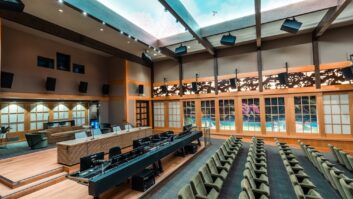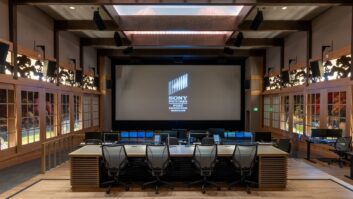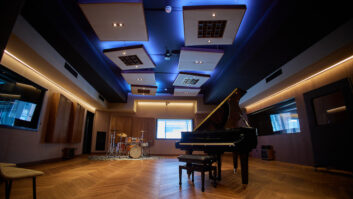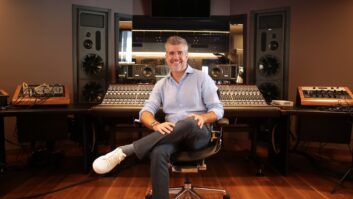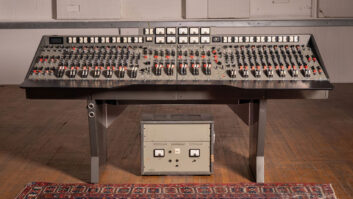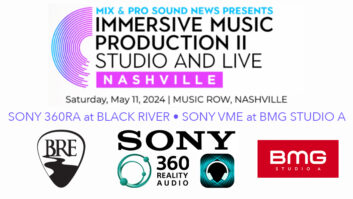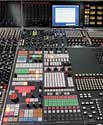

The AMS Neve 88R’s original design genesis goes back to 1998 with the first model shown at the fall 2000 AES show. But it wasn’t until the middle of 2002 when Michael J. Kohut, president of Sony Post-Production facilities, and Mark Koffman, senior VP of post-production engineering, approached AMS Neve’s Robin Porter to come up with a replacement for the facility’s 72-channel VR Legend console. Striking changes in the way major motion pictures were scored, and the specific console requirements and extra facilities requested by scoring mixers and clients, had outpaced the VR Legend’s capabilities.
“We routinely record 80 to 115-piece orchestras that need to play along with a prerecorded 60-plus — track Pro Tools session brought in by a composer,” Koffman explains. “There’s so much money involved during a typical scoring session and such tight schedules — they’ll go for about three days or finish by the end of the week and then go straight to the dubbing stage — we needed a console that could consistently keep up.”
“To us, it was very important that the console retain the immensely popular VR features like Flying Faders automation, the basic channel strip layout and the metering system,” says Porter, “so anyone familiar with a VR could sit down and immediately go to work on an 88R.”
Besides its 118 buses and huge number of I/O, Sony Pictures’ 15.5-foot 88R has 96 large faders and 96 small faders — all automatable — and in the big-ticket world of scoring, fail-safe reliability and redundancy are a must. “We’ve made tremendous strides in reliability by using redundancy in all areas of the design,” Porter emphasizes. “For example, we’re using a standard PC to store setups, for automation and to scan and store the entire console — every switch, fader and knob position — every two minutes. But the operation of the 88R does not rely on software and if the computer goes down, the console continues to operate normally with no interruption.”
In February 2003, Sony Pictures presented a design brief with serious modifications over the stock 88R to AMS Neve, with development and manufacture completed by December and installation in January 2004. (For more information on the rededication, see “Current” in the May 2004 issue of Mix.)
Part of Sony’s requirements was that its 88R had to function like a dubbing console with the ability to output six sets of surround mix stems simultaneously. To do this, there is a resource of 36 stem buses available for use in any combination of stem(s) required for the particular session: LCR, LCR, Ls, Rs, LCRS, aux 7/8; i.e., up to eight channels for each stem. The user could have six LCR buses (18), five stereo buses (10) and four stereo aux buses (eight) that can be fed from the large and small faders simultaneously. These 36 stem buses are in addition to the 48 recording buses, five stereo mixdown buses, another LCR mix bus and eight auxiliary send buses. The custom surround stem management/monitor panel was a joint design project with input from mixers Shawn Murphy, Simon Rhodes, Dennis Sands, Sony’s Pat Weber and Mark Koffman, and Jeff Foster at AIR Studios, UK.
The stem-management matrix is a marvel of engineering thought that takes into consideration every situation that could be required during the heat of an extensive surround scoring session. The composition and routing of each of the six surround stems are configured here: output path to external recorders, plus monitoring. Nonstandard surround configurations can be reconformed, and there is extensive soloing, muting and level management of each channel of each 8-channel stem. The 88R uses comprehensive fader mapping: Any fader on the board can be assigned to control any surround stem output, stem monitor or the four 2-track outputs, which can be used to generate cue mixes or master stereo mixes to the dub stage.
Sony’s console is powerful enough to output up to four different and simultaneous mixes from 48 input channels by splitting the 96-input console into two halves, each with 48 large and 48 small faders. Each set of 48 faders can be used to derive a separate mix of any stem — from 2-channel stereo to 8-channel surround. While in Split mode, the console’s aux send buses can split for separate effect sends for each half. Also unique to the Sony 88R is complete AFL surround soloing on any of the channel outputs.
“With the 88R, the scoring mixer can make and deliver any number of imaginable stem mix configurations of the same cues to the dubbing stage in one mixing pass. Not having to go back and remix because of unforeseen music, dialog or effects conflicts saves time and money,” Koffman says. “We like our clients to leave here with a 5.1 mix of the prerecords, a 5.1 of the mixed orchestra, plus whatever extra 5.1 stems they’ll need to be fully covered at the dubbing stage. That’s the direction we’re going now with the 88R, and so far the mixers and clients have been very excited about the console and its new functionality.”
Barry Rudolph is a Los Angeles — based recording engineer. Visit his Website at
www.barryrudolph.com.
The User’s Standpoint
SHAWN MURPHY ON THE 88R SCORING CONSOLE
Mix caught up with Shawn Murphy at Abbey Road Studios where he is ensconced with John Williams recording and mixing the score for the upcoming opus, Harry Potter and the Prisoner of Azkaban. Recent pictures Murphy has worked on include the mix of Mel Gibson’s The Passion of the Christ, John Woo’s Paycheck and P.J. Hogan’s Peter Pan, one of the last films Sony Pictures did before remodeling the control room and installing the new 88R. Murphy has three Oscar nominations and one win for his work on Jurassic Park.
Murphy has been involved in the design of film scoring/mixing consoles since the early 1980s, working with both AMS Neve and SSL. When he worked at L.A.’s Todd-AO, many of Murphy’s suggestions went into the final design of the monitor section for the custom SSL 9000 K console that the company purchased. Murphy worked early on and continues working with Robin Porter and AMS Neve as a nonpaid consultant — an end-user with his “wish list” of new desired console features and capabilities — all brought on by the new demands placed on the scoring process itself and the required formats of its delivered product.
“We’re being asked to deliver [to the dubbing stage] more complex scores in terms of the material — the ingredients in the score — with elements separated out more extensively than in the past,” says Murphy. “We’re doing big orchestral scores, along with choirs, soloists, synthesizers and ethnic instruments all separated out to stems. That requirement was the genesis of our discussions for the new 88R Scoring console. We needed more buses, more flexibility in routing in the monitor so we can listen to each element separately while maintaining 3-channel, 4-channel and 5.1-channel specific stem assignments simultaneously all through the process. The large monitor section and the availability of many bus assignments from each input module allows for this. These requirements were accomplished by AMS Neve on this new desk and is beyond the capability of any other desk made right now.”
On whether Sony’s AMS Neve 88R would improve the quality of his work, Murphy confides, “Honestly, we would be reluctant to say that all of this makes my mixing better, although the new desks do sound good, and in some ways, AMS Neve has bettered the quality of the old desks that we all love so much. Much of the improvement is the speed and efficiency at doing what our main tasks are: deriving the many different versions of our mix simultaneously — multiple stereo mixes, stems and film composites all at the same time.”
When asked about his current wish list, Murphy offers, “I think that most of the wishes center on the automation system now and not so much on routing and busing anymore. There will always be little software issues with assignments and other things that are locked out under certain conditions, and routing that changes depending on what mode you’re in, but AMS Neve has been very responsive. They can correct those situations with each new software iteration or hardware update.”
In the future, Murphy doesn’t see a lot of changes in score mixing itself, but new recording technology will place new demands on both the process and scoring mixers in general. “Realistically, I think we’ll be off analog tape fairly soon, and we’ll want to look at integrating digital and analog desks and control surfaces better than we have done in the past, such as a common automation system,” Murphy adds. “I also think that fairly quickly, we’ll also be asked to expand our technology knowledge beyond where it is right now.”
— Barry Rudolph

• Read George Petersen’s review of the Neve 88R here.
